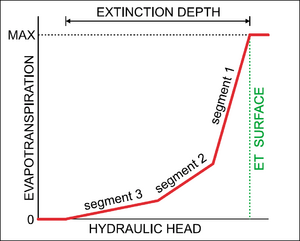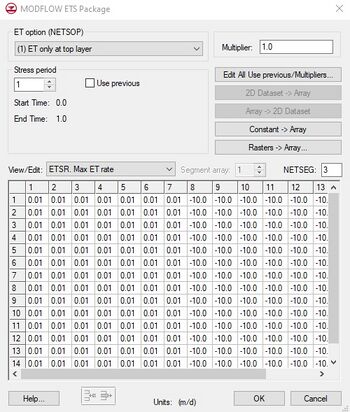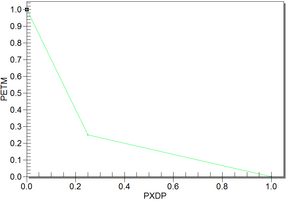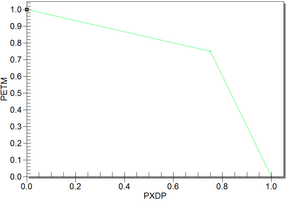GMS:ETS Package
| MODFLOW | |
|---|---|
| Pre-processing | |
| MODFLOW Commands | |
| Building a MODFLOW Model | |
| Map to MODFLOW | |
| Calibration | |
| Packages Supported in GMS | |
| Saving a MODFLOW Simulation | |
| Importing MODFLOW Files | |
| Unsupported MODFLOW Features | |
| Run MODFLOW | |
| Post-processing | |
| MODFLOW Display Options | |
| MODFLOW Post-Processing Viewing Options | |
| Reading a MODFLOW Simulation | |
| Tutorials | |
| Packages | |
| Flow: | BCF6, HUF, LPF, UPW |
| Solvers: | SMS |
| Other: | UZF1 |
The EvapoTranspiration Segments (ETS) Package is an enhancement of the EVT package and "allows simulation of evapotranspiration with a user-defined relation between evapotranspiration rate and hydraulic head."[1] It is included in MODFLOW 2000 and GMS includes an interface to it starting at version 7.0.

Evapotranspiration Segments
From the package documentation:
In the ETS1 Package, the functional relation of evapotranspiration rate to head is conceptualized as a segmented line in the variable interval. The segments that determine the shape of the function in the variable interval are defined by intermediate points where adjacent segments join. The ends of the segments at the top and bottom of the variable interval are defined by the ET surface, the maximum evapotranspiration rate, and the extinction depth. The number of intermediate points that must be defined is one less than the number of segments in the variable interval. For each intermediate point, two values, PXDP and PETM, are entered to define the point. PXDP is a proportion (between zero and one) of the extinction depth, and PETM is a proportion of the maximum evapotranspiration rate. PXDP is 0.0 at the ET surface and is 1.0 at the bottom of the variable interval. PETM is 1.0 at the ET surface and is 0.0 at the bottom of the variable interval. Segments are numbered such that segment one is the segment with its upper endpoint at the ET surface, and segment numbers increase downward. The relation of evapotranspiration rate to head is defined over the model grid by a series of two-dimensional arrays; therefore, PXDP and PETM also are specified as arrays.[1]
The input order of the arrays defining the segmented line is important and is defined in the package documentation:
PXDP-is a proportion of the extinction depth (dimensionless), measured downward from the ET surface, which, with PETM, defines the shape of the relation between the evapotranspiration rate and head. The value of PXDP must be between 0.0 and 1.0, inclusive. Repetitions of PXDP and PETM are read in sequence such that the first occurrence represents the bottom of the first segment, and subsequent repetitions represent the bottom of successively lower segments. Accordingly, PXDP values for later repetitions (representing lower segments) should be greater than PXDP values for earlier repetitions. PETM-is a proportion of the maximum evapotranspiration rate (dimensionless) which, with PXDP, defines the shape of the relation between the evapotranspiration rate and head. The value of PETM should be between 0.0 and 1.0, inclusive. Repetitions of PXDP and PETM are read in sequence such that the first occurrence represents the bottom of the first segment, and subsequent repetitions represent the bottoms of successively lower segments. Accordingly, PETM values for later repetitions (representing lower segments) generally would be less than PETM values for earlier repetitions.[1]
Segmented line functions in GMS
In GMS, the ETS segmented line function can be defined in a conceptual model. When this is done, the standard XY Series Editor is used. The XY Series Editor is a simple tool for creating 2D curves. When used to define the ETS segmented function, the X values correspond to PXDP, and the Y values correspond to PETM. The order of the values is important and is defined by the package documentation as mentioned above. PXDP should be entered in order of increasing value, and PETM should be entered in order of decreasing value. Here are a couple of examples:
| Values | Plot | ||||||||
|---|---|---|---|---|---|---|---|---|---|
|
|||||||||
|
In a GMS conceptual model, it is not possible to define segmented lines which vary with time. However, this can be done in the ETS Package dialog.
Notes
- ^ a b c d Banta, Edward R. (2000), MODFLOW-2000, The U.S. Geological Survey Modular Ground-Water Model-Documentation of Packages for Simulating Evapotranspiration with a Segmented Function (ETS1) and Drains with Return Flow (DRT1). Open-File Report 00-466., Denver, Colorado, http://water.usgs.gov/nrp/gwsoftware/modflow2000/ofr00-466.pdf
| GMS – Groundwater Modeling System | ||
|---|---|---|
| Modules: | 2D Grid • 2D Mesh • 2D Scatter Point • 3D Grid • 3D Mesh • 3D Scatter Point • Boreholes • GIS • Map • Solid • TINs • UGrids | |
| Models: | FEFLOW • FEMWATER • HydroGeoSphere • MODAEM • MODFLOW • MODPATH • mod-PATH3DU • MT3DMS • MT3D-USGS • PEST • PHT3D • RT3D • SEAM3D • SEAWAT • SEEP2D • T-PROGS • ZONEBUDGET | |
| Aquaveo | ||


